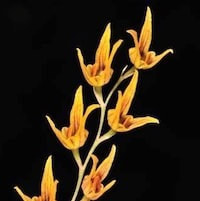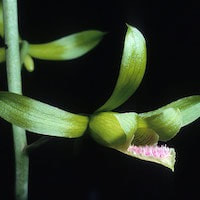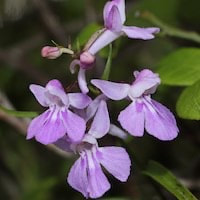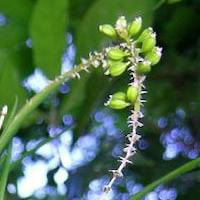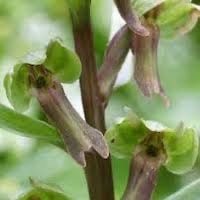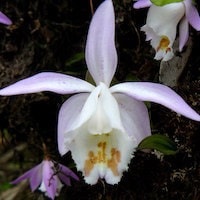MC3- Men's Citrus 3 - Between a lime and a Yuzu
|
Native Singaporean Orchid notes: Polystachya Bella
Polystachya Bella, a captivating orchid not native to Kenya and Uganda, flourishes in their lush rainforests at elevations of 6000 to 6400 feet. Its fragrant flowers, about 1 inch wide, bloom successively on a petite plant up to 8 inches tall. Though uncommon locally, its heavenly scent makes it a coveted addition to our prestigious fragrance collection.
|
Therapeutic Orchid notes:
|
Bulbophyllum reptans
Bulbophyllum reptans, also known as Fushengshidou Lan in Chinese, is prized for its medicinal benefits. This orchid is used in traditional Chinese medicine to nourish Yin, clear phlegm, improve appetite, aid digestion, and soothe dry throat. Scientific studies have identified several beneficial compounds such as phenanthrenes, including coelonin and flavanthrin, which contribute to its therapeutic properties. |
|
Eulophia epidendraea (J.Koenig ex Retz) C.E.C. Fisch.
Eulophia epidendraea, a terrestrial orchid native to southern India, Sri Lanka, and Bangladesh, contains beneficial compounds in its tubers such as beta-sitosterol and flavonoids in its leaves. Traditionally, these tubers are used as a vermifuge, demulcent, and analgesic. They are applied externally to relieve muscle pain and are also used in treating anorexia and anthrax in animals, highlighting its medicinal value. |
|
Hemipilia cordifolia Lindl. Syn. Hemipelia yunnanensis (Finet) Schltr.
The Yunnan beak tongue orchid, also known as Xinyeshehui Lan, thrives across Nepal, Bhutan, northeast India, Myanmar, Xizang, Yunnan, Sichuan, and Taiwan, often at elevations from 1500 to 3500 meters. In Taiwan, it grows specifically in the Central Mountain Range at altitudes of 2500 to 3000 meters. Traditional Chinese medicine highly values its root for kidney health, using it to treat conditions like hernia and kidney diseases due to its diuretic properties. |
|
Oberonia caulescens Lindl. ex Wall.
This orchid species, known by multiple names including hare lip white orchid and split leaf jade orchid, is found extensively across northern India, Sikkim, Bhutan, Nepal, Tibet, Yunnan, Sichuan, Hunan, Hubei, Guangdong, Taiwan, and Vietnam. In traditional herbal medicine, the entire plant is valued for its ability to stop bleeding and alleviate bruises. It is applied as a paste on fractures and wounds, and in India, the tubers are specifically used to treat biliary disorders, prepared with black pepper for consumption before meals. |
|
Peristylus bulleyi (Rolfe) K. Y. Langherbal syn. Herminium bulleya (Rolfe) Tang & F.T. Wang
This orchid species, known as stripe leaf broad pistal orchid and stripe leaf angle plate orchid, is native to China, thriving in pine forests and grassy slopes at elevations of 2500 to 3000 meters. It is mainly found in southwest and west Sichuan, as well as north and northwest Yunnan. Blooming from July to August, it is valued in traditional Chinese medicine for its ability to invigorate the kidneys, strengthen the loins, and treat conditions like lumbago and kidney weakness. It is especially noted for its potential benefits in improving male reproductive health and addressing issues related to kidney function. |
|
Pleione hookeriana (Lindl.) Rollisson
The orchid Maochundusuan Lan, also known as hairy lip single garlic/bulb orchid, provides valuable medicinal herb from regions including Hubei, Guangdong, Guangxi, Guizhou, Yunnan, and Tibet. Its pseudobulbs are prized in herbal medicine for their ability to clear heat and toxins, and treat abscesses, snake bites, and lymphatic tuberculosis. These pseudobulbs are valued for their anti-inflammatory and antibacterial properties, promoting health and healing. |
Other scent note
Scentopia Library Reference ingredient
Lime - Check details at Scentopia's scent library
Download the guided mediation that works best with this Orchid fragrance oil
| men_citrus_essential_oil_orchi_00003.mp3 | |
| File Size: | 111079 kb |
| File Type: | mp3 |

